BK Blog Post
Five Ways Capitalism Is Saving Lives
 Posted by
Jeevan Sivasubramaniam,
Managing Director, Editorial,
Berrett-Koehler Publishers Inc.
Posted by
Jeevan Sivasubramaniam,
Managing Director, Editorial,
Berrett-Koehler Publishers Inc.
In Peter Georgescu's new book, he discusses the importance of capitalism and business to create greater balance and shared wealth instead of the dangerous path it is on now towards self-serving ends.
The truth remains that capitalism can serve people and still be profitable--successfully earning dividends for businesses while also helping the gneral public. Here are five cutting-edge for-profit sectors and companies that are literally saving lives through capitalism:
1. Making Malaria History: The problem thus far has been that all efforts to eradicate malaria have been focused on mosquitos, but Artepham, a Chinese company, has decided to kill the disease, not the carrier. In tests in the Comoros, the strategy has resulted in a 95% reduction in new infections.
2. Water Purification via Coca-Cola: Dean Kamen (inventory of the Segway) came up with the idea for the Slingshot -- a simple and cheap tool for water purification. But how to get this into the various regions where it is most needed? That's the real genius of this product: Kamen partnered with Coca-Cola for distribution. After all, where in the world can you NOT get Coca-Cola, right?
3. Pre-fab Education: Taking the lead from prefab houses and shops, Bridge International has now created, in various nations in Africa, prefab schools. These schools, which are bare-bones, and come with highly standardized curriculums that are almost entirely scripted to maximize learning in the shortest amount of time possible with downloadable materials and lesson plans. Children in the schools scored 35% higher in reading and 19% higher in math than kids in government schools. The cost? Approximately $6 per month.
4. Robotic Food Tasters: Humans are not always capable of discerning the difference between quality food and drink and substandard products. Now Spanish researchers have built an "electronic tongue" which can accurately distinguish the differences between numerous varieties of beer. Before you laugh, know that beer is, next to water, one of the most highly consumed drinks in the world. Being able to determine variations in the levels of yeast, hops, and other components means that the technology can also be used to verify the nutritional makeup of foodstuffs to ensure that proper nutrition is being provided when promised.
5. Selling Food in Slums: If small-scale food vendors in developing countries like Kenya had the purchasing clout of Walmart, they could cut costs and pass on the savings to their customers. Enter SokoText, a text-message-based startup. By aggregating individual purchasing orders, SokoText can obtain produce on behalf of local fruit and vegetable vendors at wholesale prices. (Kiosk owners use cellphones to text orders and pick them up from a nearby outlet the following day.) The for-profit venture, led by Canadian CEO Jonah Brotman, keeps a portion of the margin (it buys at 30% below retail and sells to vendors at 20% below) and aims to generate more revenue through mobile phone ads.






